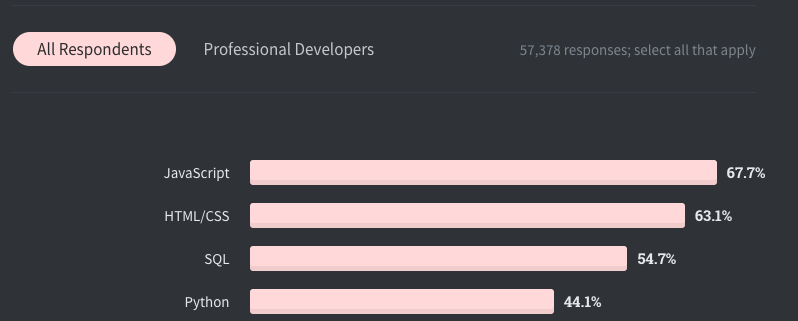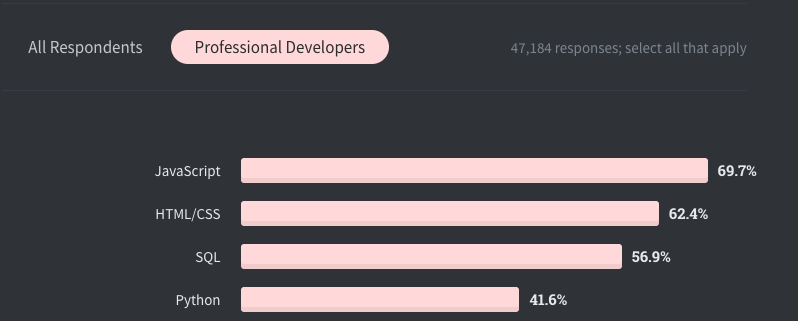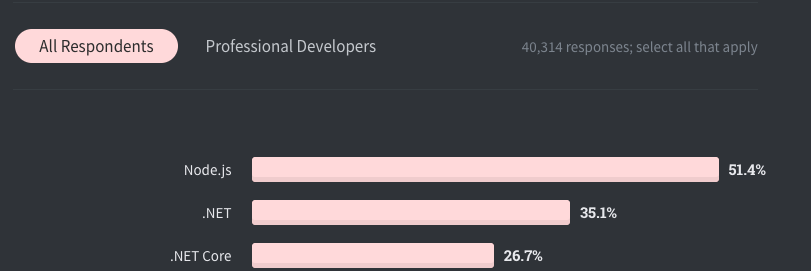Judging from online search queries, people often wonder what is better in the node.js vs. Python battle. It’s a difficult question to answer, as they are not even the same category of tools, although there is a lot of overlap between the user cases for both. Python is an object-oriented programming language, Node.js is not. Node.js is a runtime environment, and language used here is JavaScript (also object-oriented to some extent). That means that when you write in Node.js, you’re actually using the same language (JavaScript) for both the front end and the back end. Because they’re from different categories, in order to compare Node vs. Python, we’ll have to look at slightly different criteria then when comparing programming languages, with JavaScript being indirectly compared here as well. We shall still however see which one will satisfy your software needs best! Python vs. Node.js: the final throw down.
Node.js vs Python: in numbers
Stack Overflow
Stack Overflow’s 2020 was the 9th consecutive year for the survey with 90,000 developers responding. More information on SO’s website: https://insights.stackoverflow.com/




- Because they are not ranked in the same category, Python being a programming language and node.js classified as “other frameworks, libraries, and tools”, direct comparison is impossible.
- In their categories, Python ranks four with over 40% of professional developers using the language, and node.js comes top with over 50% of respondents using it.
- This means that node.js is slightly more popular, but as it has narrower use and uses the most popular language for StackFlow’s users, this can be explained partly by the popularity of JavaScript.
Python vs. node.js from the managerial perspective
Python vs. node.js: use by junior programmers
- Points for Python
- Python is very beginner-friendly, evidenced by it being the most popular introductory language in the U.S. universities. Most of the mistakes and errors junior developers may make in some frameworks are far more forgivable and less of a menace moving forward.
- Issues with Node.js
- Inexperienced Node.js developers can slow down development in many ways by making mistakes common to people who don’t fully grasp some of the more advanced concepts and insights of working in JavaScript.
- This may be a result of the way JavaScript has grown over the years. Concepts like object-oriented programming received meaningful attention only after plenty of far less elegant code snippets and tutorials emerged online.
Scalability and flexibility
- Points for Node.js
- Node.js saves you the need to create a large cohesive core. Instead, you create a set of microservices and modules, with each item communicating with a lightweight mechanism and running its own process. You can easily add an extra microservice and module, which makes the development process flexible.
- Also, Node.js web apps are easily scalable, both horizontally and vertically. To scale it horizontally, you just add new nodes to the system you already created. To scale it vertically, you can add extra resources to the nodes you already have.
- It also offers greater flexibility when it comes to typing. You can use either a weakly-typed JavaScript or a strongly-typed TypeScript.
- Issues with Python
- Enabled multithreading is essential for scalability. But because Python uses Global Interpreter Lock (GIL) it doesn’t support multithreading very well. Although Python does provide libraries for multithreading, it is not "true" multithreading.
- Even if you have multiple threads, Python’s GIL doesn’t allow the interpreter to perform tasks simultaneously but rather makes it run only one thread at a time. Although multiple interpreters can be launched to execute multiple calls at the same time, communication may get more expensive as a result.
- Python cannot go without using GIL, even despite its negative effects on performance, because the language’s memory management is not thread-safe.
- What’s more, Python is dynamically-typed. Unfortunately, dynamically-typed languages are not very suitable for large projects with growing development teams. As the system built in Python grows, it gradually becomes excessively complex and thus difficult to maintain.
Node.js vs. Python: Versatility
- Points for Node.js
- Because Node.js uses JavaScript for both the frontend and the backend, you don’t need multiple different technologies to run the entire application. This means you don’t need your developers to learn yet another version of the same programming paradigms, and they can easily jump in to fix an issue that may have resulted from someone else’s code.
- This also allows for one team to handle both ends, which can decrease inconsistencies and bugs. You may even share parts of the code between the front end and the back. This reusability of code can save time and money.
- Node.js makes developing a variety of cross-platform (web, mobile, Internet of Things, cloud) applications feasible, hence reducing development costs and efforts.
- Points for Python
- Python also can be used for frontend and backend cross-platform development (although to lesser extent) and comes bundled with macOS and Linux.
- Issues with Python
- Although it’s a powerful programming language for both web and desktop development, it lacks support for mobile development, making it sometimes an impractical choice.
Node.js vs. Python: performance and speed
- Points for Node.js
- Node.js is based on Google’s V8 engine, which makes its speed impressive for an interpreted language.` It’s often preferred for real-time applications as it is remarkably fast.
- Also, Node.js executes the code outside the web browser, so applications are more resource-efficient and perform better. This also allows for use of features that can’t be used in browsers, such as raw TCP sockets.
- Node.js has an event-driven and non-blocking architecture allowing multiple contexts to run concurrently, which allows for creating highly concurrent programs like web servers with ease.
- Issues with Python
- Python is relatively slower in performance as it processes requests in a single flow, unlike the multithreading-enabled Node.js. The use of the Django framework may increase its performance to handle high loads to some extent, but scaling to large numbers of users is still more complex than with Node.js.
Python vs. Node.js from developer perspective
Developers focus on different features when looking for a language to learn and develop in.
Both Python and Node.js (JavaScript) are easy to learn, so it's difficult to say objectively which one is simpler. One is not considered easier than the other, however it needs to be noted that inexperience in Node.js can cause more problems and future costs for the project, as previously mentioned.
Architecture and syntax
- Points for Node.js
- Node.js is designed as an event-driven environment, which means it enables asynchronous input/output. As a given process is called as soon as the respective event occurs, no processes block the thread waiting for IO, as long as the user takes proper precautions. This event-driven architecture of Node.js is perfectly suitable for the development of web services such as chat applications and web games.
- Points for Python
- Python’s simple syntax makes it possible to express some classes of problems more succinctly than with JavaScript. Python is free of curly brackets, making it easier to both understand and to debug for some developers.
Community
Both Python and Node.js boast numerous and active communities. Both languages are also well-documented and offer tons of tutorials and community-based extensions.
Libraries and packages
- Points for Python
- In Python, PIP (“Pip installs Python”) manages libraries and packages. It’s fast, reliable, and easy to use, so developers also find it easy to learn. Python has a multitude of actively maintained libraries across applications; with an especially impressive number of data science libraries.
- Points for Node.js
- In Node.js, the Node Package Manager (NPM) or Yarn are used to manage libraries and packages.
- NPM is one of the biggest repositories of software libraries available. It’s fast, well-documented, and easy to learn. With over 1.3 million packages, NPM beats PIP just by the sheer volume, proving how extensible node.js can be with an appropriate package.
- All the packages on NPM are also conveniently available with a simple search. Recent versions of NPM and Yarn in general support lockfiles, making for more reliable development as dependency versions change.
Python vs. Node.js: a summary
Both Python and Node.js are very powerful tools for developing web applications. Whether you should use one or the other will depend on two main factors: what’s the purpose of the project and the level of skill of the developer. Both will deliver most of general commercial applications. While Python’s strengths lie mostly at the back end, JavaScript (which is the basis of Node.js) is suitable for both back end and front end, with established superiority when it comes to the front. However, Node.js is strictly a backend runtime environment. Undoubtedly, Python should be used for apps utilizing scientific algorithms or are data-intensive (such as analytics). It’s also easy to maintain and safer if you have a junior team. Node.js on the other hand offers better speed of execution, concurrent processing and hence faster applications, in part because of its ability to control both front and back end processes. This end-to-end standardization is its best attribute. Python will serve best for everything that’s not web-based and requires handling a lot of data. Node.js on the other hand is a great shout for real-time and cross-platform mobile/web apps.
Python vs. Node.js: differences and uses
| | Python | node.js |
| Good for | Statistics, data analyticsMachine learningfintechData-heavy sites and servers with high-traffic volumeData VisualizationImage ProcessingNeural NetworksVoice and Facial Recognition | Website developmentWeb applicationsMobile appsAsynchronous programmingInternet of ThingsMemory- and data-intensive apps including Data Intensive Real-time Applications (DIRT)MessengersChatbotsComplicated single-page appsCollaboration systemsStreaming platforms |
| Bad for | Data processing—it is not designed to perform well in highly specialized apps for data processingAsynchronous programmingMobile applications | Anything that is not web-basedNode.js lacks the clean coding standards so best avoid with huge and robust projects |
- Number7 in TIOBE index
- Used by69,7%Developers
- Loved by58,3%Developers
- Primary language39%Developers
- Want to learn18,5% Developers



